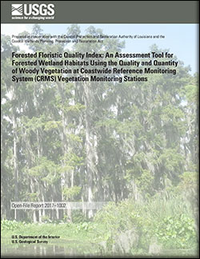Forested floristic quality index: An assessment tool for forested wetland habitats using the quality and quantity of woody vegetation at Coastwide Reference Monitoring System (CRMS) vegetation monitoring stations
Links
- Document: Report (2.45 MB pdf)
- Download citation as: RIS | Dublin Core
Abstract
The U.S. Geological Survey, in cooperation with the Coastal Protection and Restoration Authority of Louisiana and the Coastal Wetlands Planning, Protection and Restoration Act, developed the Forested Floristic Quality Index (FFQI) for the Coastwide Reference Monitoring System (CRMS). The FFQI will help evaluate forested wetland sites on a continuum from severely degraded to healthy and will assist in defining areas where forested wetland restoration can be successful by projecting the trajectories of change. At each CRMS forested wetland site there are stations for quantifying the overstory, understory, and herbaceous vegetation layers. Rapidly responding overstory canopy cover and herbaceous layer composition are measured annually, while gradually changing overstory basal area and species composition are collected on a 3-year cycle.
A CRMS analytical team has tailored these data into an index much like the Floristic Quality Index (FQI) currently used for herbaceous marsh and for the herbaceous layer of the swamp vegetation. The core of the FFQI uses basal area by species to assess the quality and quantity of the overstory at each of three stations within each CRMS forested wetland site. Trees that are considered by experts to be higher quality swamp species like Taxodium distichum (bald cypress) and Nyssa aquatica (water tupelo) are scored higher than tree species like Triadica sebifera (Chinese tallow) and Salix nigra (black willow) that are indicators of recent disturbance. This base FFQI is further enhanced by the percent canopy cover in the overstory and the presence of indicator species at the forest floor. This systemic approach attempts to differentiate between locations with similar basal areas that are on different ecosystem trajectories. Because of these varying states of habitat degradation, paired use of the FQI and the FFQI is useful to interpret the vegetative data in transitional locations. There is often an inverse relation between the health of the overstory and health of the herbaceous community beneath it because of resource competition (for example, light) and differing environmental preferences between the two communities. The herbaceous layer vegetation responds rapidly to basic environmental factors such as flooding, salinity, and nutrients and can offer insight into the sustainability of swamps on a temporal scale shorter than tha of the slowly growing woody vegetation.
The FFQI will be available via the CRMS spatial viewer (http://lacoast.gov/crms2/home.aspx), and a new score will be calculated annually for each CRMS forested wetland site as data are collected to establish trends, to compare among sites, and to evaluate specific restoration projects when applicable. The FFQI will identify forested wetland areas in need of restoration and conservation and will help define targets and trajectories for restoration planning.
Suggested Citation
Wood, W.B., Shaffer, G.P., Visser, J.M., Krauss, K.W., Piazza, S.C., Sharp, L.A., and Cretini, K.F., 2017, Forested Floristic Quality Index—An assessment tool for forested wetland habitats using the quality and quantity of woody vegetation at Coastwide Reference Monitoring System (CRMS) vegetation monitoring stations: U.S. Geological Survey Open-File Report 2017–1002, 15 p., https://doi.org/10.3133/ofr20171002.
ISSN: 2331-1258 (online)
Study Area
Table of Contents
- Abstract
- Introduction
- Methods
- Results
- Discussion
- References Cited
| Publication type | Report |
|---|---|
| Publication Subtype | USGS Numbered Series |
| Title | Forested floristic quality index: An assessment tool for forested wetland habitats using the quality and quantity of woody vegetation at Coastwide Reference Monitoring System (CRMS) vegetation monitoring stations |
| Series title | Open-File Report |
| Series number | 2017-1002 |
| DOI | 10.3133/ofr20171002 |
| Publication Date | February 08, 2017 |
| Year Published | 2017 |
| Language | English |
| Publisher | U.S. Geological Survey |
| Publisher location | Reston, VA |
| Contributing office(s) | Wetland and Aquatic Research Center |
| Description | iv, 15 p. |
| Country | United States |
| State | Louisiana |
| Online Only (Y/N) | Y |


